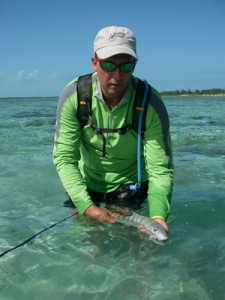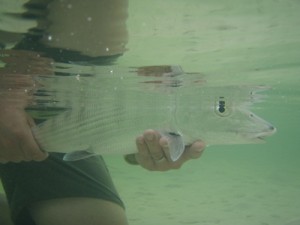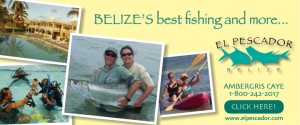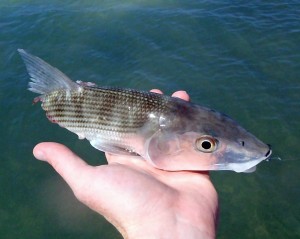Andy Danylchuk, Ph.D. is one of the foremost researchers when it comes to bonefish. He’s a pretty interesting guy and his work is critical to those of us who like to chase silver on the flats.
I recently got to meet Andy at the IFTD show in Reno. I pumped him for good info and asked him to do an interview for the blog, which he agreed to. Here it is.

A friend of Andy’s with a good release photo. (photos from Core Angling).
Andy, what has you particularly excited when it comes to bonefish, tarpon or permit research right now?
Still so much more to discover. Although anglers focus so much on these icons, we still know relatively little about them. Every piece of research about their ecology, movement patterns, and best way to handle them once caught can contribute greatly to the conservation and management of this trio.

Photo from Core Angling.
What has you most concerned when it comes to bonefish right now?
Not learning enough about them in time to make the best decisions related to their conservation and management. For instance, it wasn’t until a few years ago when we finally had some stats related to how air exposure can influence the susceptibility of bonefish to predation following release. Many have seen bonefish getting attacked by sharks and cudas after letting them go, but one of our studies showed that for every minute of air exposure, the chances of a predation increases by six times. Even if half of the anglers targeting bonefish work to eliminate air exposure for the fish they catch, that increases the chances of survival for a good number of fish. Same is true for learning about their essential habitats, like where the juveniles live or where bonefish spawn. It wasn’t until recently did we discover that bonefish in The Bahamas form large aggregations and move to deeper offshore waters to spawn. Finding and protecting these spawning aggregation sites might prove to be a critical piece of the ‘conservation’ puzzle.
What is one of the weirdest things you’ve seen out on the flats?
First on my list would be golf balls – I have a collection of them from various flats. It is amazing how startling it is to come across a golf ball when you are in a search pattern for bonefish or permit. The second oddest was a computer monitor that got caught up in the mangroves.
Every once in a while someone comes up with a claim of a 20 pound bonefish. Hawaii, New Caledonia, South Africa. Do you think there is a 20 pounder out there and if so, do you think it could be caught?
Anything is possible
What should the individual angler be doing to help preserve bonefish populations?
Learn and apply best practices for catch-and-release. Minimize or better yet, eliminate air exposure; reduce handling time by using barbless hooks and simply being prepared; stay tuned for updates from groups such as Bonefish & Tarpon Trust as these best practices become more detailed/refined. Also, just recognizing that one person – the angler – can make a difference when it comes to each fish they interact with.

Another good release. Photo from Core Angling.
What more should the industry be doing to preserve bonefish populations?
Promote a general conservation ethic – having advertisements and magazine articles describing and showing images that reflect known best practices; showing support, even in a non-monetary way, for conservation efforts.
Thanks Andy. Keep up the good work.
—







